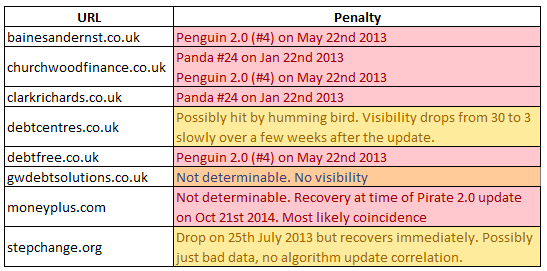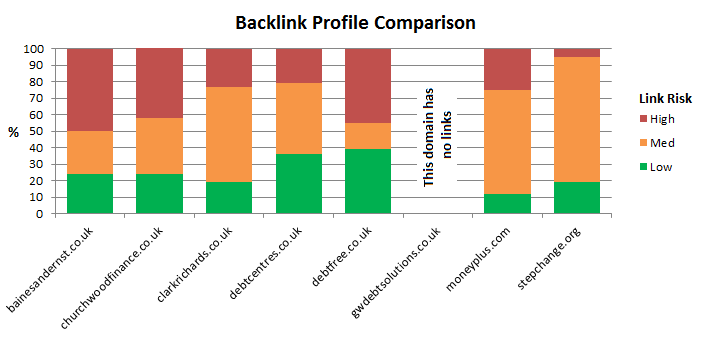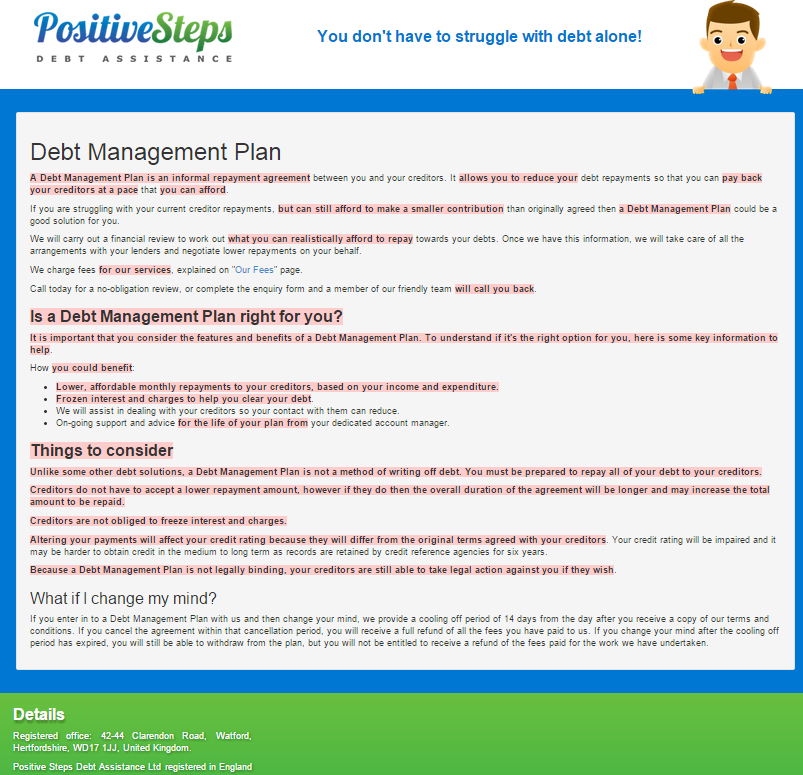
Content
Debt management companies: Whose search strategy is paying off?
Feb 18th, 2015Debt is a worry for most of us at some point in our lives. We all think we can manage it ourselves, but sometimes it doesn’t work out that way. Click Consult has taken eight debt management sites and have analysed in depth their search engine visibility to see why they are not performing as well as they could
Who is coming under our microscope?
The eight companies we are testing are:-
– BainesandErnst.co.uk
– ChurchwoodFinance.co.uk
– ClarkRichards.co.uk
– DebtCentres.co.uk
– DebtFree.co.uk
– GWDebtSolutions.co.uk
– MoneyPlus.com
– StepChange.org
Search visibility
The search visibility of a site indicates how often and at what position it is seen in the SERPs for relevant search terms. A higher visibility is better. The majority of the sites we have chosen have very poor visibility, less than 50 in most cases, which indicates that they are rarely appearing in the search results.
The question we have to ask now is why do most of these sites have such poor visibility? We need to focus on their historic visibility to look for trends.
Let’s turn our attention to BainesandErnst.co.uk. We ran the site through Search Metrics to see their historic visibility graph.
The sudden drop in visibility around 1.5 years ago indicates some form of penalty. By analysing this drop and comparing it with the Google algorithm update history, we can quickly see that it was hit by Penguin 2.0, an algorithm designed to target sites with low quality links.
DebtFree.co.uk also suffered an immediate drop at the time of the Penguin 2.0 update which is a strong indication that it was also penalised.
The visibility of ChurchwoodFinance.co.uk also dropped in the last couple of years, as demonstrated below:
This website appears to have been hit by Panda #24 almost 2 years ago rather than Penguin. Panda is an algorithm designed to combat low quality content. ClarkRichards.co.uk appears to have been impacted by the same update. We’ll go into the Panda algorithm in more detail later in the blog.
Interestingly, during our check of StepChange.org we found a massive drop to a visibility of 534.
We tried to match this against an update but it didn’t correlate with any of them so we have put this down to an error in the data. This just goes to show the danger of relying on a single metric. Had this been the latest data point, mass panic could have set in if this was one of our clients so it’s why we always check multiple data sources. In this case, chances are the site was down for a few days or Search Metrics had issues themselves. The immediate recovery would suggest a temporary issue of some kind and is usually not cause for concern.
A quick look at DebtCentres.co.uk shows its visibility was fairly short lived:
This drop occurred at around the time of the new Hummingbird algorithm introduction (it’s an algorithm designed to help give better results by focusing on the meaning behind the words of content) and suggests that it may have been hit negatively, but we can’t say for sure because it could just be coincidence. Their visibility was fairly poor before the update and jumped up and down just before too. With the visibility only approaching a very low number of 30, the jumps can seem large even though the actual values were small.
Half of the sites we analysed have almost certainly been hit by either Penguin or Panda over a year ago when comparing the correlations on their search visibility with algorithm updates.
Two of the sites, MoneyPlus.com and GWDebtSolutions.co.uk have no determinable penalties. MoneyPlus.com shows a recovery of some kind but this only coincides with the Pirate 2.0 update (relating to sites which have received lots of Digital Millennium Copyright Act requests), which would more likely to lead a drop in visibility than an increase so this is not a likely correlation with an algorithm change. GWDebtSolutions.co.uk has zero visibility at present and has not had any visibility in the previous two years.
Penalty summary
Future Penguin penalty risk
For all 8 debt management domains, we analysed the backlink profile and categorised all of their links into high risk, medium risk and low risk.
Graph data source: Link Detox
The more high risk and medium risk links that the domains have, the more likely they are to be hit with Penguin penalties in the future, or if they already have a penalty, the less likely they are to successfully recover. It’s the nature of the way search works to expect some low, medium and high risk links to point to all sites we analyse, but what matters is the ratio. More good links (low risk) versus bad links (medium and high risk) are what your backlink profile needs to stay healthy and your site to rank well.
High risk
BainesandErnst.co.uk, ChurchwoodFinance.co.uk and DebtFree.co.uk have the highest ratio of high risk links. These links are typically associated with those that you would never place in a well-structured SEO campaign. They tend to fall under generic directory links, blog comment spam, forum posts and similar. These are all low quality and their only purpose is to gain a link at any cost without regard to relevancy or the quality. Always avoid these types of links unless they have been specifically sought from a good quality site where the posts/comments are closely moderated for quality.
Medium risk
Medium risk links don’t fare much better. Typically we see this situation when the sources of the inbound links to a site have themselves high risk links pointed to them and some of this risk filters through.
Whilst significantly less dangerous, too many medium risk links, such as those that ClarkRichards.co.uk, MoneyPlus.com and StepChange.org have, compared to low risk links, can lead to a Penguin penalty. StepChange.org is currently the healthiest site from our selection. This said however, their risk of a Penguin penalty still falls on the sheer number of medium risk links that they have.
Our recommendation in the case of StepChange.org would be to analyse each high and medium risk link for their true risk to the backlink profile. We would then make a decision on whether the link poses a real danger to the site, and if it does, whether it is worth removing or not. Removing links would reduce their search visibility and rankings, so any links removed must be replaced with a healthy link to offset this change.
Who’s at the lowest risk?
DebtCentres.co.uk has the most equal splits of low, medium and high link risk so I would classify their overall risk as the safest from this list of 8 sites; however their overall number of links is fairly low at just 77 links (second lowest to GWDebtSolutions.co.uk which have none) so their chances of page 1 rankings are also low.
Gwdebtsolutions.co.uk has no links so we were not able to analyse the risk. Suffice to say that if they truly have no links as our analysis indicates then their risk of a Penguin penalty is non-existent in the first place.
Our advice
In conclusion of this part of the analysis, all of the sites need to closely inspect and regulate the types of links they are receiving as part of their link building campaigns. Natural links are harder to regulate, but tend to be of higher quality due to their increased relevancy.
Our eBooks, Build Clean, Build Organic and Link Building Through Outreach go into further detail about creating a good linking profile.
Links and anchor text
Whilst gaining links to your site is important, the anchor text used on each link also plays its own part. If the anchor text is the same for every single link, the result will be over optimisation of that term and the chances of ranking diminish very quickly.
One of the domains, DebtCentres.co.uk has massively over optimised theirs by using their URL as the anchor text for 94% of their links. This is certainly not a case of natural link building.
StepChange.org has done something similar, with 50% of their links having URL based anchor text. There is only one variation with a high number of links which would indicate that they have been manually created.
ClarkRichards.co.uk also have over optimised anchor text but instead of their URL they have used “debt management” on 77% of their link anchors.
MoneyPlus.com decided that focusing a large amount of attention on “consumer ratings of moneyplus” as a key phrase would be a good idea. This might indicate that they had bad reviews in the past and this is an attempt at reputation management to fix negativity towards the brand.
DebtFree.co.uk have used the keyword “debt free” in 9 of their top 10 anchor texts and as a result it’s become over optimised:
Source: Ahrefs
Having an exact match domain the same as the keyword you are targeting used to be very beneficial. However, things changed in September 2012 during the exact match domain update which saw 10% of all exact match domains reduce in visibility because they were low quality domains.
Our advice
The right way to use anchor text on your links is to use lots of different phrases and keywords, and to have a good distribution of them. Don’t focus on any one or two terms, target them all. You should also include your brand name a lot as you want people to find you not only for what your services are but your company name too. You will find that a natural anchor text profile will have a majority focus on brand anchors with other phrases having a fair spread.
BainesandErnst.co.uk is an example of a site with a good spread of anchor text. Below are the top 10 anchor phrases for the entire site. Their anchor text spread is split between keyword, brand and URL. It’s worth noting however there is a little too much focus on ‘debt help’ which could be a sign of unnatural and manual link building towards this keyword, but the brand, URL and other keywords are in a fair balance.
Content quality and the Panda algorithm
Of the 8 sites tested, two currently still have Panda penalties against them (according to our analysis). The purpose of the Panda algorithm was to devalue sites with low quality content. Sites are likely to get hit if their content is scraped from other sources, if their content is nonsense or if it’s generally just thin.
Churchwoodfinance.co.uk and ClarkRichards.co.uk were both hit by the Panda #24 update on 22nd January 2013. The result was a drop in overall site visibility – a penalty.
ChurchwoodFinance.co.uk at first glance looks fine. The content is useful, informative and not too thin. But when we dive into further analysis and run the site through a duplicate content checker, we find that the content on some pages also exists on other sites. For example, http://www.churchwoodfinance.co.uk/debt-management.asp contains much the same content as http://www.positivesteps.com/pay-what-you-can-afford/dmp.html. One of the two sites has copied this content from either the other or another site (duplicate text is in pink below).
The same is true of other pages on the ChurchwoodFinance.co.uk site. Duplicate content on the web is a big no in the eyes of search engines. They don’t want to see content they have already seen on other sites; they want fresh and unique content. In many cases if they see your site copying content and they know another site is the original author, they’ll just devalue your site so the other site ranks for that content instead. This domain has had a new site on it in the last 6 months, but obviously the content is not new.
The ClarkRichards.co.uk site has also suffered from a Panda penalty and looking at their website it does not appear to be an issue any longer. By using archive.org we can determine that there was a new website built on the domain between August and December 2014, so it’s possible that there has been no Panda issue on the site since that time. Our tests didn’t indicate any duplicate copy and the content is well written. It’s likely that during the next Panda update the site will see some recovery.
You can find out more about optimising your website content by downloading our Simple Guide to Organic Search eBook.
The verdict
The quality of sites in the debt management industry leaves a lot to be desired. Half of the sites studied have penalties either from Panda or Penguin, several others are at risk from a Penguin penalty, and only one that we looked at (StepChange.org) ranks well at all. All of the other sites have near zero visibility.
All of the sites need to focus their attention on the quality of the links being built. The industry is heavy in low quality links from sites trying to take advantage of someone’s financial situation, and there are plenty of low quality articles surrounding the subject too. Continuing to build these types of links will only result in a penalty in the future. However, this does indicate that there is a large opportunity for content gap analysis and for the creation of high quality links.
Six of the 8 sites have over optimised anchor text and they should focus on correcting this. Our advice would not to edit these but to start building new links with different anchor text to offset the over optimisation.
Besides these issues, the sites are generally in good shape with very little to comment on with regards to on-page issues. With the right SEO campaign, these sites could become top in their field.









